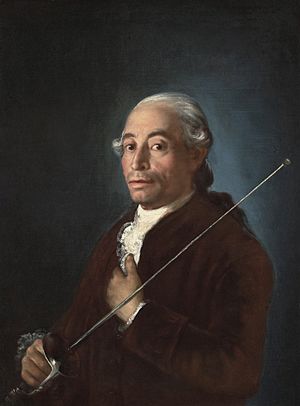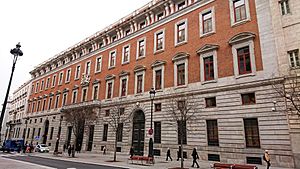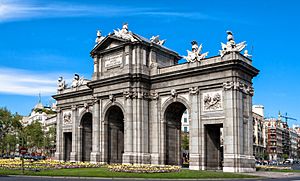Francesco Sabatini facts for kids



Francesco Sabatini (born 1721, died 1797) was a famous Italian architect. He is best known for his amazing work in Spain, especially for King Charles III. He designed many important buildings and helped shape the look of Madrid during the 1700s.
Biography of Francesco Sabatini
Francesco Sabatini was born in Palermo, Italy. He studied architecture in Rome, learning how to design and build structures.
He first worked for the Spanish royal family when he helped build the grand Palace of Caserta in Italy. This was for King Charles VII of Naples, who later became King Charles III of Spain.
When Charles III became King of Spain in 1759, he invited Sabatini to Madrid in 1760. Sabatini quickly became one of the most important architects in Spain. He was put in charge of all royal building projects. He also became a high-ranking officer in the Engineers Corps and an honorary member of the Royal Academy of Fine Arts.
Sabatini's buildings are in the Neoclassical style. This means they were inspired by the classic designs of ancient Greece and Rome. However, Sabatini mostly looked to the Italian Renaissance architecture for his ideas.
Because of his great talent and the King's support, Sabatini received many important jobs. He was promoted to a very high rank in the Engineers Corps. He was also made a Knight of the Order of Santiago, a special honor. He even became a "Gentleman of the Royal Chamber," which meant he had direct access to the King.
You might have heard of the Sabatini Gardens in Madrid, which are near the Royal Palace of Madrid. However, Francesco Sabatini did not design these gardens. They were actually built in the 1930s on the land where stables he had built used to be.
Sabatini also designed other important buildings outside of Madrid. These include the Arms Factory in Toledo. He also built the headquarters for the Walloon Guards in Leganés, which is now part of the Charles III University of Madrid. He designed convents in Valladolid (Santa Ana) and Granada (Comendadoras of Santiago). He also worked on the Chapel of the Immaculate in the Burgo de Osma Cathedral.
Francesco Sabatini died in Madrid on February 19, 1797.
Key Works and Projects
Francesco Sabatini worked on many important buildings and city projects. Here are some of his most famous contributions:
- Royal Palace of Madrid (1760–1764): He helped finish the construction of the grand Royal Palace of Madrid.
- Madrid's Sewage System (1761–1765): He planned and helped build a new sewage system for Madrid. This was part of a big project to improve the city.
- Royal Customs House (1761–1769): He designed the Royal Customs House on Alcala Street. Today, this building is used by the government.
- Tombs of Ferdinand VI and Bárbara de Braganza: He designed the tombs for King Ferdinand VI of Spain and Queen Bárbara de Braganza. These are located in the Church of Santa Barbara in Madrid.
- Convent of San Pascual (1765–1770): He built the Convent of San Pascual in Aranjuez.
- Cuesta de San Vicente Renovation (1767–1777): He helped renovate and improve the area around the Cuesta de San Vicente in Madrid.
- Royal Palace Expansion (1772): He began extending the southeastern wing of the Royal Palace.
- Monastery Reconstruction (1773): He rebuilt the monastery of the Comendadoras of Santiago.
- Puerta de Alcalá (1774–1778): One of his most famous works is the beautiful Puerta de Alcalá, a large gate in Madrid.
- Basilica of San Francisco el Grande (1774–1784): He oversaw the construction of the Basilica of San Francisco el Grande.
- Puerta de San Vicente (1775): He also designed the Puerta de San Vicente gate.
- Palace of Godoy (1776): He designed the Casa de los Secretarios de Estado y del Despacho, also known as the Palace of Godoy.
- General Hospital Works (1776–1781): He continued the work on the General Hospital. This building is now the famous Museo Nacional Centro de Arte Reina Sofía art museum.
- Convent of San Gil (1786–1797): He worked on the Convent of Franciscan of San Gil.
- Royal Palace Stairs (1790s): He changed the direction of the main stairs in the Royal Palace for King Charles IV of Spain.
- Plaza Mayor Reconstruction (1790s): After a fire in 1790, he helped rebuild the Plaza Mayor de Madrid with another architect, Juan de Villanueva.
- Military Base in Leganés: Sabatini planned a military base in Leganés. The construction was finished by José de Hermosilla in 1783. Today, this site is part of the Charles III University of Madrid.
See also
 In Spanish: Francesco Sabatini para niños
In Spanish: Francesco Sabatini para niños


